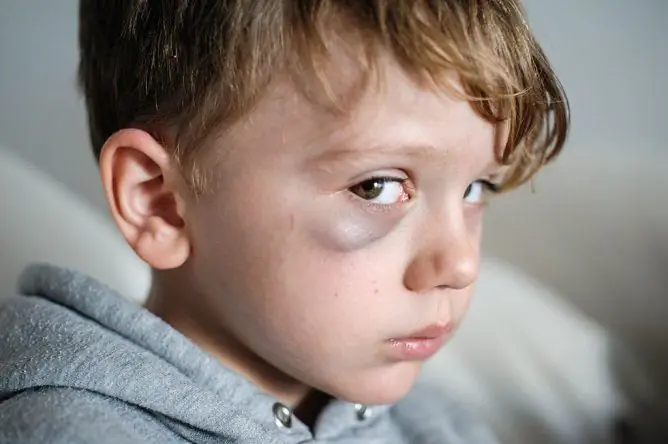How to distinguish a bruise from a fracture: symptoms, first aid
The content of the article:
-
Signs of injury
- The danger
- First aid
-
Signs of bone fracture
- Diagnostics
- The danger
- First aid
- Video
How to distinguish a bruise from a fracture - this question is especially important in order to understand how to provide first aid correctly, and what the possible consequences are.

Bruises and fractures are common types of injury
Bruises, fractures, dislocations, sprains are quite common injuries, especially during the winter season. It is not uncommon for people, after a fall or impact, to not attach much importance to them. As a result, the victims do not turn to a qualified specialist in a timely manner and do not receive full assistance.
Therefore, in case of injury, it is important to provide first aid with high quality and immediately contact the trauma center or the nearest hospital.
Signs of injury
A bruise (or contusion) is considered to be a closed injury to soft tissues (skin, subcutaneous tissue, muscles, internal organs, periosteum) without significant changes in their anatomical shape and structure.
Bruised wounds are caused by falling or being hit with a blunt object.

In order to correctly diagnose an injury, you should contact a traumatologist
In order to determine a fracture or contusion, it is necessary to know the characteristic clinical symptoms of contused wounds, including:
- severe pain at the time of injury, gradually subsiding after it;
- the formation of edema during the day;
- violation of motor functions (with large bruised wounds of muscles or tissues located near the joints).
In case of injury to superficially located tissues, a bruise (hematoma) occurs, which has a specific blue-violet color, after a while it changes to yellow-green. The deeper the bruised wound is located, the longer the visible hematoma will appear.
The danger
Bruised injuries are not always harmless, as many believe. For example, if you bruise the lower leg in the place where the skin and subcutaneous tissue adjoin directly to the bone (anterointernal surface), necrosis of the skin with its further rejection is possible.
In some cases, when striking weakly protected tissues, the periosteum may detach. When blood is soaked into the joint cavity, hemarthrosis (joint hemorrhage) may form.
Accompanying a bruised head wound with loss of consciousness, nausea and vomiting is more likely to indicate a brain injury and concussion.
First aid
The main actions that must be taken before seeking qualified help (if this cannot be done immediately):
- Apply cold (ice, a cloth soaked in ice water, a bottle of water from the refrigerator, etc.) to the bruised area.
- Provide rest in the affected limb or area.
- After 3-4 hours, apply a pressure bandage to the bruised area and make sure that it does not disturb the blood supply and innervation (numbness and paleness of the skin of the limb below the bandage indicates that it is too tight).

First aid consists of exposing the site of injury to cold
Signs of bone fracture
The term bone fracture means a complete or partial violation of the anatomical integrity of the bone, which occurs as a result of the impact of force on a site of the skeleton that exceeds its strength.
Due to their occurrence, fractures are divided into two large groups:
| View | Description |
| Traumatic | Caused by traumatic (mechanical) exposure |
| Non-traumatic | It arises as a result of a pathological process in which even a slight mechanical effect provokes a fracture: tuberculosis, tumor and metastatic formations in the bone, etc. |
For violation of the skin:
- open: with skin damage;
- closed: no damage to the skin.
By severity of damage:
- complete: with and without displacement of bone fragments;
- incomplete: cracks, breaks.
Diagnostics
The diagnosis is established by a doctor using absolute and relative signs and then confirmed by X-ray methods.

An X-ray must be taken to confirm the diagnosis
Relative criteria (typical of many traumatic injuries and are indicative):
- soreness at rest, aggravated by active movement or exertion;
- swelling (edema) localized at the site of injury;
- bruising at the site of injury: may pulsate, which indicates ongoing bleeding from a ruptured vessel;
- limitation or impossibility of movement in the injured limb: for example, with a fracture of the clavicle, the human hand hangs down, there are minor movements in the elbow joint.
Absolute criteria (indicate the presence of a fracture, make it possible to distinguish it from other types of injuries):
- limb deformation;
- uncharacteristic (pathological) mobility: movement of the limb in an uncharacteristic place (where there are no joints);
- crunching or crepitus, which are audible at a distance (more clearly - when pressed with a stethoscope in the projection of the injured area) or felt tactile;
- bone fragments are visible in the wound or rise along with the skin (with an open or closed fracture, respectively).
The danger
Fractures can be complicated or uncomplicated.

One of the possible complications of a fracture is fatty embolism
Possible complications:
- traumatic shock;
- fat embolism (fat from the inside of the bone into the bloodstream);
- damage to internal organs;
- bleeding;
- the addition of a bacterial infection with subsequent inflammation of the bone marrow and even the development of sepsis.
First aid
To help the victim before his delivery to a medical institution consists of the following steps. It is necessary to try to assess the condition of the victim, to recognize the place of injury.
Immobilization (immobilization) of the limb is carried out by applying a splint with the capture of the joints above and below the injured limb. To do this, you can use any durable improvised item that immobilizes the limb. If necessary, the patient is taken to a medical facility.

The injured limb should be immobilized
Due to the similarity of the clinical picture, it is not often possible to immediately recognize different types of injuries. For example, it is extremely difficult to distinguish between a bruise and a fracture of a foot or hand. The only difference is the deformation of the phalanx of the finger, which occurs only with a fracture, but this symptom is not always observed.
Therefore, in case of injury, it is recommended to seek qualified help as soon as possible to establish an accurate diagnosis with its confirmation by additional diagnostic methods, to prescribe timely and adequate treatment, as well as to exclude possible immediate and distant complications.
Video
We offer for viewing a video on the topic of the article.

Anna Kozlova Medical journalist About the author
Education: Rostov State Medical University, specialty "General Medicine".
Found a mistake in the text? Select it and press Ctrl + Enter.







